 Back to selection
Back to selection
Shutter Angles
Conversations with DPs, directors and below-the-line crew by Matt Mulcahey
DP Paul Yee on The Fits, Achieving Close Eyelines and Getting an Unexpected Steadicam Bump
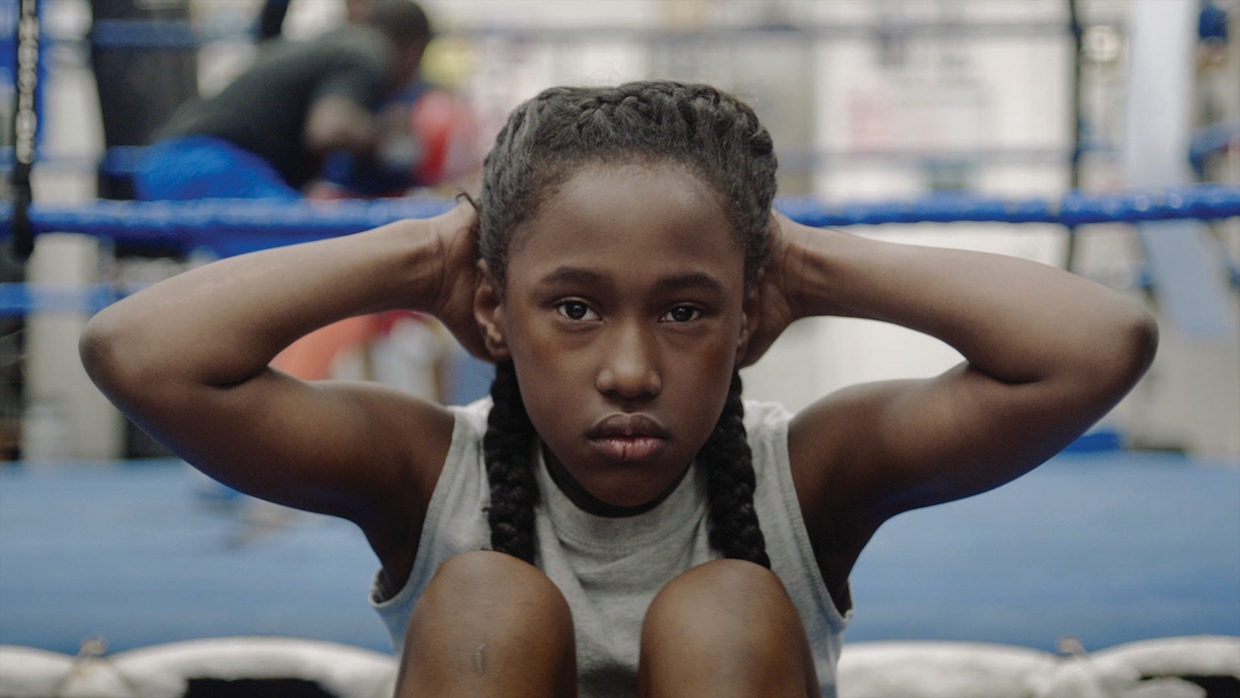 Royalty Hightower in The Fits
Royalty Hightower in The Fits In the opening shot of The Fits, the slender frame of 11-year-old tomboy Toni glides in and out of a static medium shot as she counts off sit-ups while peering down the center of the camera’s lens. The image embodies the distinctive dichotomy of the film’s style – a mixture of neorealism and abstract lyricism that taps into the simultaneous horror and yearning of adolescence. The influence of neorealism is found in the cast of non-actors (led by Royalty Hightower as Toni) and the setting, a community center in Cincinnati where a mysterious wave of seizure-like fits strikes the dance team Toni has just joined. The lyricism is located in the imagery of cinematographer Paul Yee.
With the festival favorite now out in limited theatrical release, Yee spoke to Filmmaker about prepping his first narrative feature, taking inspiration from The Silence of the Lambs, and how an unwelcome rain spurred one of The Fits‘ most memorable shots.
Filmmaker: We met on a commercial you were shooting in Cincinnati last summer where I was your assistant camera and I remember you telling me about this little indie movie you had just shot in town. That “little indie movie” turned out to be The Fits.
Yee: Yeah, I’m definitely spoiled that The Fits is my first feature. It’s done pretty much as well as a really small budget movie can possibly do. It had an amazing festival run and got theatrical distribution, so it’s actually finding an audience. The press has been wonderfully complimentary as well. Maybe I should just retire from features now (laughs) because I don’t know if I’ll ever be so fortunate again.
Filmmaker: There isn’t a great deal of dialogue in the film. Could you tell at the script stage this was going to be something special?
Yee: I knew that it was going to be worthwhile because director and co-writer Anna Rose Holmer was involved. She’s somebody I’ve collaborated with since we were both at NYU. She has a gift for finding beauty in things that people would normally see as mundane. Once we started shooting with Royalty, it became clear that she completely understood the character of Toni and was just nailing every take. I think that’s what makes The Fits so unique — this incredible character that Anna created and Royalty portrayed.
Filmmaker: With this being your first narrative feature as a DP, what was your prep like?
Yee: On a small film there are so few things that you can control that it helps to understand everything that you can control. I came down to Cincinnati a month before the official prep started and really mapped out that whole [community center] building that we’d be shooting in. I did blueprints of the entire space and took note of where the sun would be rising and setting and checked out the practical bulbs that were already in place. So when we started shooting and the inevitable schedule conflicts arose I knew what time of day each room would have appropriate natural light. Generally, I try to work with what’s available as opposed to forcing a space to be something it’s not.
Filmmaker: Does working with a cast of non-actors affect the way you do things? For example, do you try to put lighting units further away from the actors or use longer lenses so the camera isn’t so physically close to them?
Yee: The movie centers around Royalty Hightower’s character Toni and we learned early on that we could treat her like an experienced actor who could hit marks. She never seemed to be distracted by the camera or the lights. There were plenty of scenes with fairly complicated blocking marks and she always hit them. That being said, there are other scenes in the movie where we did have to stay far back to capture a scene. There’s a scene where Toni’s friend Beezy (played by Alexis Neblett) is following Toni around the gym asking her questions. With a scene like that, we just let Alexis dance and play however she wanted. We stayed back on a wide lens and just let her be a kid and I think that’s why that scene is so natural and funny.
Filmmaker: I haven’t heard about that many features being shot on the Arri Amira. What led you to that choice?
Yee: We were back and forth for awhile on what camera we wanted to shoot with. The ideal situation for us was shooting with an Arri camera because of how accurately it renders color. We were dealing with some darker skin tones and natural light situations and I wanted to make sure we had a camera with high latitude that wouldn’t fall apart when it was underexposed slightly. And because it was a small crew — basically just one assistant camera (Jason Chau) and then a combo media manager/2nd AC (Eric Ransbottom) in the camera department — we wanted to go with a camera body that was lighter. This was before the Alexa Mini was released, so the Amira seemed like the perfect option for us.
Filmmaker: How about selecting the older Cooke S2s for your lenses?
Yee: Part of it just came down to price. Originally I wanted to go with the S4s, which I’d used many times before, but the S2s, which I hadn’t used before, were about half the cost. I ended up really loving the imperfections of the S2s. This particular set was uncoated so there were interesting aberrations with lens flares and a soft, imprecise bokeh.
Filmmaker: What was your grip and electric package like?
Yee: We had a decent amount of grip but not a whole lot of lights, which is typically how I like to work. I think the largest light we had was an M18, which is an Arri 1.8K light, and even that we only had for a week and a half of the shoot. Other than that we had a 1.2K Par HMI, a Joker 800, a bunch of Kino Flos, and just a few tungsten units for the night scenes that we did, including a Leko and a few Triolets with various shaped chimeras. Several scenes were lit with the available light in the space, like in the boxing gym, where we softened the light from the existing fixtures by attaching large billowing diapers of full grid diffusion and bleached muslin. We didn’t even change the bulbs in there. They were all just some GE brand cool white that you could get at Home Depot, which was budget and schedule friendly. We just made sure to have a spare bulbs around in case we needed to throw them in a Kino.
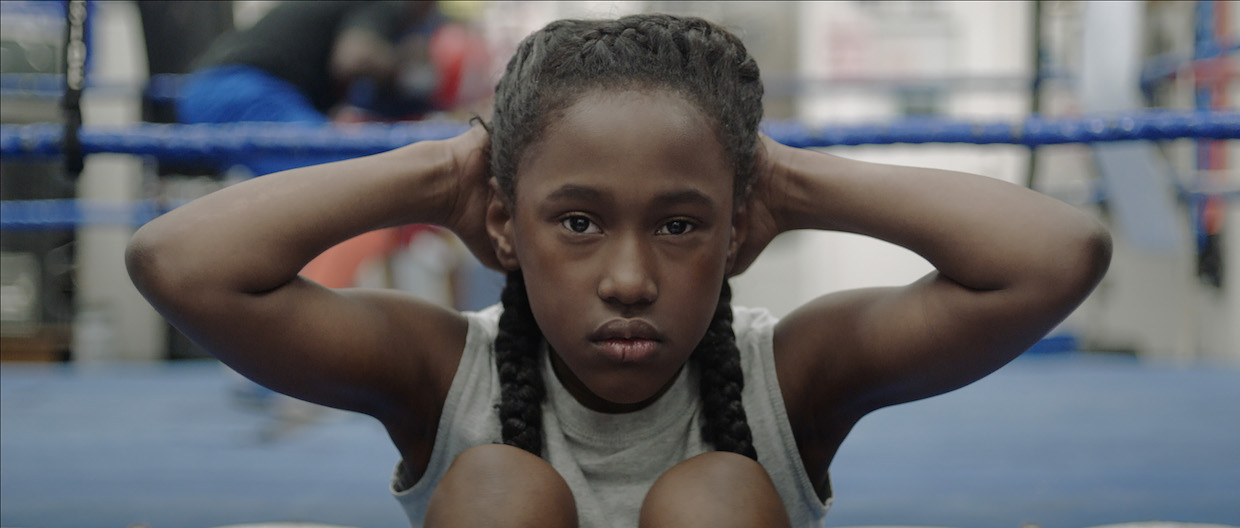
Filmmaker: Let’s break down a few shots, beginning with the opening image from the film. Her eyeline looks to be straight down the barrel of the lens.
Yee: I think she’s actually looking right above the lens in that shot.
Filmmaker: I don’t know, it looks pretty close to me.
Yee: We told her she should be looking right above the lens. Our intention throughout the filming was to keep Toni’s eyeline as close to the lens as possible so that you feel a connection with her. I also watched The Silence of the Lambs the night before we started shooting and I think because of that I was hyperaware of how tight your eyeline can be and still feel appropriate. So many movies are shot multi-camera nowadays that actors are performing to each other farther off camera [because the multiple cameras would be in each others’ shots]. Furthermore, when you’re shooting with a widescreen aspect ratio and you’re covering an over-the-shoulder, shot-reverse-shot dialogue scene the eyeline is typically more distant because of how far apart the characters are in the frame. But because The Fits is mostly Toni interacting with the world around her (and many of her close-ups are shot clean), we were able to keep her eyeline tight to the lens, which increases the intimacy of the performance.
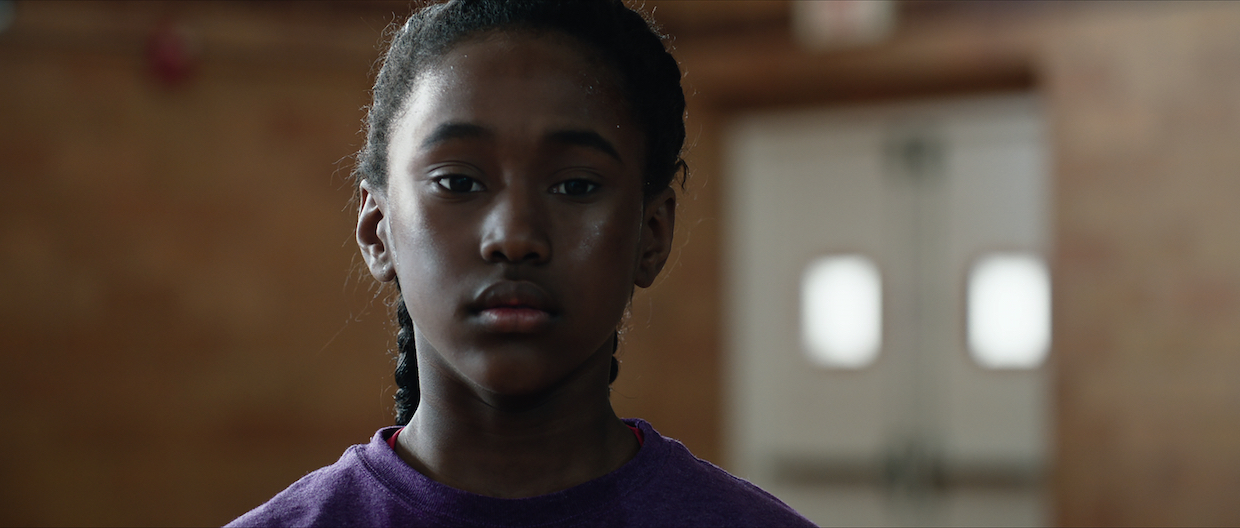
Filmmaker: Each of the fits in the film is shot with a different style — the first with very controlled camera moves, including the frame above, which is a dolly-zoom shot of Toni’s reaction.
Yee: That was a zoom in/dolly out that we shot on a Canon cinema zoom 30-105mm. As you mentioned, the camera is constantly moving during that scene. We wanted it to feel fraught and anxious but still controlled. For Toni’s reaction shot, we wanted the world around her to be warping and distorting so the zolly seemed like our best option.
The shot itself was actually surprisingly easy to execute. We thought it would take a while to get right, but we just tried it for a few minutes before lunch and got it on the second or third take.
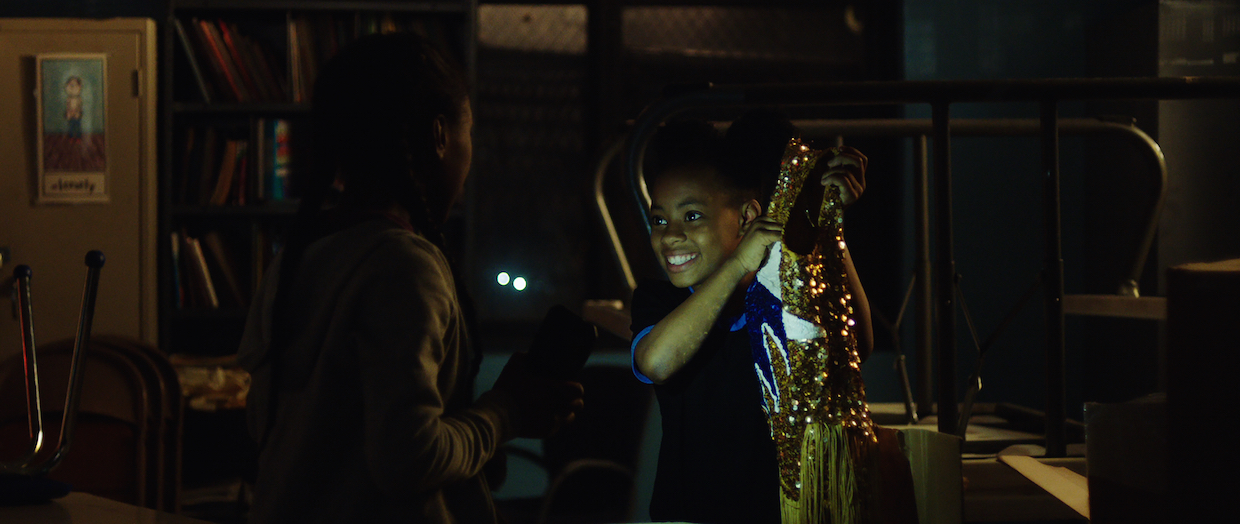
Filmmaker: The next frame is from a scene where Toni and Beezy sneak into the center and try on the team’s newly-arrived uniforms. It’s one of the few night scenes in the film, and also one of the few scenes with lighting that isn’t cool white in temperature.
Yee: We wanted the community center at night to be polluted by the light pollution that would seep in from the city — green traffic lights, sodium vapor street lights, and red exit signs. I was nervous about this scene because it was so lighting intensive and we didn’t have a ton of resources. To help sell the darkness of the space, we wrote in a cellphone flashlight for Toni to carry with her, which is something the girls would use anyway to explore that space. We blocked Royalty to occasionally flare the lens with the iPhone flashlight, which created a nice soft flare and lowered the contrast on the whole scene.
The background is lit by a Leko with quarter straw and yellow, replicating the hard cast of a sodium vapor street lamp, and then the box of uniforms was lit by a five-foot Octobank. Outside of the picture window is a 15 watt firefly just so it doesn’t fall to complete darkness. In the take that made the movie, there’s also headlights from a car that drove by that was totally unintentional, but gave us a nice little lighting gag that added life to the shot.
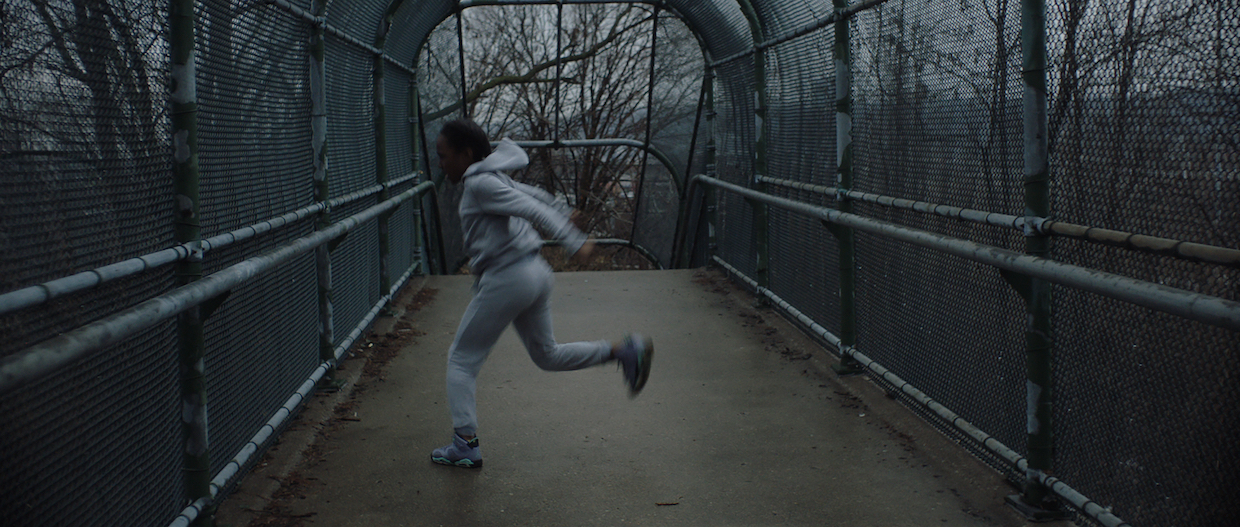
Filmmaker: Let’s finish up with one of the most striking shots from the film – a three-minute take that tracks Toni up the stairs of a highway overpass that she typically runs with her boxer brother. Once on the overpass, her boxing exercises turn into dance moves.
Yee: There’s a whole story behind that shot. It’s pretty much exactly halfway through the movie and is a transformative scene for Toni. We originally shotlisted that scene to be frenetic and to have a lot of cuts. There were shots of Toni doing sit-ups. There were shots of her doing push-ups. Shots of her doing jumping jacks. It would all eventually crescendo with her performing the dance routine. But on the day it was raining so we had to limit the amount of time that Royalty was outside because it would’ve been a continuity nightmare if she got soaked and her wardrobe got wet and we just didn’t want her to get sick from the cold rain. Anna came up with the idea of doing it in one long Steadicam shot. We rehearsed the camera blocking three or four times with Royalty wearing a poncho and our Steadicam wrapped in trash bags. The first take that we did where she took off the poncho, her performance was just unbelievable. There were some timing things like the way her braids flew out of her hoodie, that we were never going to be able to replicate. We watched the take back a few times and Anna just loved it and she called it at that point. I look back at it and I feel like if we had done another take we could’ve done the camera action better, but I think I’m the only one who thinks about that.
We asked so much of our Steadicam operator Devon Catucci, who was with us for the whole run of the show. It was really a blessing for us to have that cinematic tool at our disposal. Every night Anna and I would sit and talk about how we were going to approach the scenes for the next day and to have the option to be able to say, “This sort of feels like it should be a Steadicam scene” was such a luxury.
Filmmaker: That tracking move up the steps has a slight bump or shake in it, which was something I actually enjoyed seeing. We’re at a point where it’s so easy to stabilize camera moves in post that many shots feel artificially smooth. I miss some of the imperfections you see in older movies where the camera moves feel more organic.
Yee: Before the second fit there’s a Steadicam shot where we follow the girls as they run up a ramp and there is a bump that was very much an accident, but other DP’s have reached out and asked how we added that little shake to the shot. To be honest, I think on that take there was just something on the Steadicam rig that wasn’t tightened. We were definitely aiming to be precise and weren’t intending to do things in a less-than-perfect way, but it’s something that totally works in that shot because it’s a tense moment and it makes the camera feel alive.
Matt Mulcahey writes about film on his blog Deep Fried Movies.
